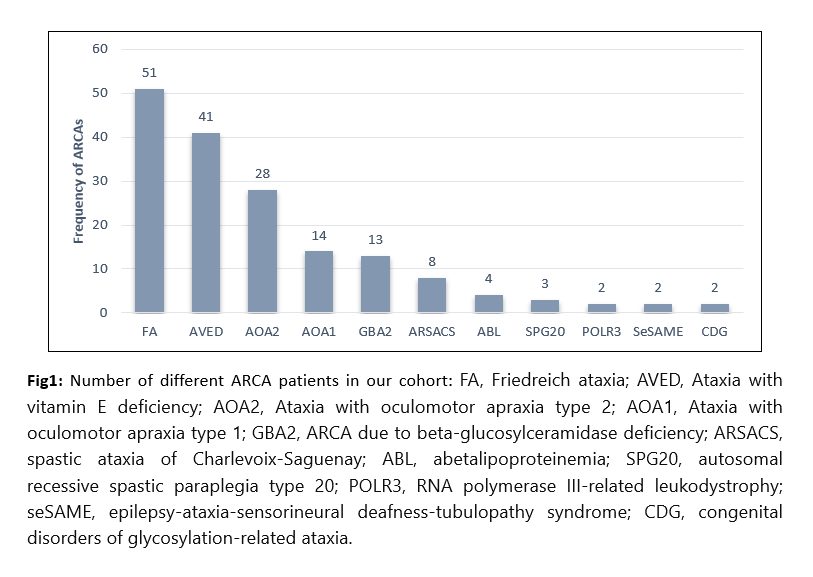Category: Ataxia
Objective: The aim of our study is to describe epidemiological, clinical and paraclinical features of the different autosomal recessive cerebellar ataxias (ARCA) identified in our population.
Background: ARCAs are complex and rare neurodegenerative disorders. Their prevalence and phenotype vary from one ethnic group to another and from one country to another.
Method: It is a retrospective study, conducted at the National Institute of Neurology (INN) Mongi Ben Hmida in Tunis over 41 years (1982-2023), and involving patients with genetically confirmed ARCA. clinical and paraclinical data were collected and analyzed.
Results: we collected 168 patients (sex-ratio= 1.2) belonging to 101 families [figure 1], with a mean age at onset of 11.57 years ± 7 [1,35]. Consanguinity was prevalent at 92.3%. Apart from cerebellar ataxia, patients exhibited spasticity (all GBA2, ARSACS, SPG20 and POLR3 patients), Babinski sign (ARSACS: 100%; FA: 90%; AOA1: 79%; AVED: 78%; GBA2: 77%; SPG20: 67%; AOA2: 64%), amyotrophy (AOA1: 100%), movement disorders (AVED: 83%; AOA1: 50%), oculomotor apraxia (AOA1: 76%; AOA2: 75%; CDG: 100%), ocular telangiectasia (AOA1: 50%; CDG: 100%) and orthopaedic deformities (all SPG20 patients; ARSACS: 88%; ABL: 75%; FA: 55%; AVED: 46%; AOA1: 43%). cardiomyopathy, diabetes and deafness were only described in FA patients. Low vitamin E level was found in AVED (95%) and ABL (100%), Elevated alpha-fetoprotein (75%) and hypertriglyceridemia (25%) in AOA2, and hypercholesterolemia (43%) and hypoalbuminemia (100%) in AOA1. Cerebellar atrophy was frequent in AOA2 (82%) and ARSACS (62%) cases. EMG revealed sensory axonal neuropathy in most FA cases (73%), while sensory-motor axonal neuropathy was prevalent in AOA2 (90%), AOA1 (82%), GBA2 (67%), ABL (67%), ARSACS (62%), and the 2 CDG cases. An axono-demyelinating neuropathy was exclusively found in the ARSACS group (37%).
Conclusion: This is the first large cohort of patients with genetically confirmed ARCA in Tunisia. Our study illustrates the frequency and heterogeneity of ARCAs in North Africa.
Frequency of different ARCAs in Tunisia
To cite this abstract in AMA style:
L. Hlioui, R. Zouari, R. Amouri, MZ. Saied, D. Ben Mohamed, A. Rachdi, S. Ben Sassi. Autosomal recessive cerebellar ataxias: a Tunisian cohort of 168 patients [abstract]. Mov Disord. 2024; 39 (suppl 1). https://www.mdsabstracts.org/abstract/autosomal-recessive-cerebellar-ataxias-a-tunisian-cohort-of-168-patients/. Accessed April 18, 2025.« Back to 2024 International Congress
MDS Abstracts - https://www.mdsabstracts.org/abstract/autosomal-recessive-cerebellar-ataxias-a-tunisian-cohort-of-168-patients/

